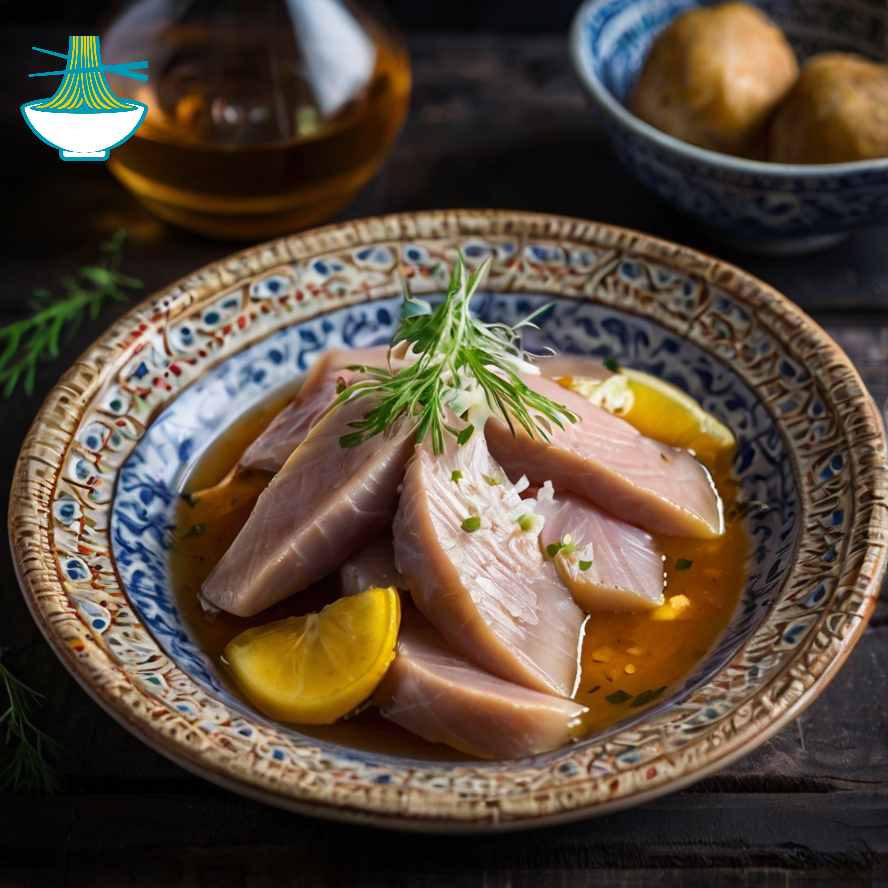Discover the unique flavors of Iceland with this traditional dish. Hákarl, or fermented shark, is a cultural delicacy known for its strong, ammonia-like smell and rich, complex taste. Follow this authentic recipe to prepare and enjoy this Icelandic specialty at home!
Here's a basic recipe for Hákarl, or fermented shark:
Ingredients:
- 1-2 kg (2-4 lbs) shark meat, preferably from a Greenland shark
- 500g (1 lb) coarse sea salt
- Large, shallow container with a lid
- Rocks or weights
- Drying rack
Instructions:
1- Obtain shark meat: Greenland shark is traditionally used for Hákarl. Note that the meat must be properly prepared to remove toxins.
2- Cut the shark into large pieces, about 5-10 cm (2-4 inches) wide.
3- Spread a layer of coarse sea salt in the bottom of the container.
4- Place the shark pieces on top of the salt, and cover them completely with more salt.
5- Place rocks or weights on top of the shark to press it down.
6- Cover the container with a lid and let it ferment for 6-12 weeks. During this time, the shark will release ammonia and develop a strong odor.
7- After fermenting, remove the shark from the container and rinse off the salt.
8- Hang the shark on a drying rack in a cool, airy place for 2-4 months, allowing it to dry and develop its unique flavor.
9- Once dried, cut the shark into small pieces and serve as a traditional Icelandic delicacy.
Note: Hákarl has a very strong flavor and smell due to the fermentation process, so it is recommended to enjoy it in small amounts.
Nutritional Values:
Here are approximate nutritional values for the main ingredients used in making Hákarl:
1-2 kg (2-4 lbs) Shark Meat (Preferably Greenland Shark):
- Calories: About 1,600-3,200 kcal (depending on weight and fat content)
- Fat: 40-80g
- Carbohydrates: 0g
- Protein:300-600g
Benefits: High in protein and essential nutrients like omega-3 fatty acids. Supports muscle growth and overall health. Greenland shark is known for its firm texture and can be a rich source of nutrients when properly prepared.
500g (1 lb) Coarse Sea Salt:
- Calories: 0 kcal
- Fat: 0g
- Carbohydrates: 0g
- Protein: 0g
Benefits: Used for curing the shark meat. Enhances flavor and acts as a preservative. Should be used in moderation to manage sodium intake.
Large, Shallow Container with a Lid:
- Calories: 0 kcal (container itself)
- Fat: 0g
- Carbohydrates: 0g
- Protein:0g
Benefits:Essential for the curing process to hold the meat and salt. Provides no nutritional value but is necessary for the preparation.
Rocks or Weights:
- Calories:0 kcal (weights themselves)
- Fat: 0g
- Carbohydrates:0g
- Protein: 0g
Benefits:Used to keep the meat submerged under the salt. Provides no nutritional value but is important for proper curing.
Drying Rack:
- Calories: 0 kcal (rack itself)
- Fat: 0g
- Carbohydrates: 0g
- Protein: 0g
Benefits:Used for drying the cured shark meat. Provides no nutritional value but is essential for the curing and drying process.
Preparation Summary:
Curing: The shark meat is cured with coarse sea salt to draw out moisture and preserve it. This process involves layering the meat with salt in a large container, using rocks or weights to keep it submerged.
Drying: After curing, the meat is placed on a drying rack to air-dry. This helps develop the texture and flavor of the preserved shark meat.
The result is a preserved product that can be used in various traditional dishes, particularly in Nordic and Icelandic cuisine.
Keep in mind that these values are approximate and can vary based on factors such as the specific type of shark meat used and the salt content in the recipe. Additionally, the fermentation and drying process may alter the nutritional composition of the final product.


Comments